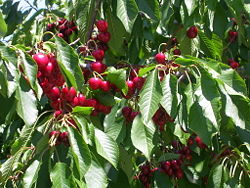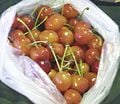Difference between revisions of "Cherry" - New World Encyclopedia
Katya Swarts (talk | contribs) |
Rick Swarts (talk | contribs) |
||
| Line 45: | Line 45: | ||
''[[Prunus x yedoensis]]'' (Yoshino Cherry) | ''[[Prunus x yedoensis]]'' (Yoshino Cherry) | ||
}} | }} | ||
| − | + | '''Cherry''' is the common name for various [[tree]]s or [[shrub]]s comprising the subgenus ''Cerasus'' within the [[genus]] ''Prunus'' of the rose family [[Rosaceae]], a genus that also includes [[almond]]s, [[peach]]es, [[plum]]s, [[apricot]]s and [[bird cherry (subgenus)|bird cherries]]. The term also refers to the fleshy [[fruit]] ([[drupe]]) of these plants, which contains a single stony seed, or to the wood of these plants. | |
| + | |||
| + | The cherries selected for eating primarily are derived from two species, the [[wild cherry]], ''P. avium'', which has given rise to the sweet cherry to which most cherry [[cultivar]]s belong, and the [[sour cherry]] (''P. cerasus''), used mainly for cooking and [[jam]] making. The black cherry, ''P. serotina'', is popular for construction, and the Japanese cherry, ''Prunus serrulata'', with its beautiful cherry blossoms, is a popular ornamental tree. | ||
| + | |||
| + | ==Description== | ||
| + | ''Prunus'' is a [[genus]] of [[plant]] in the family [[Rosaceae]]. Rosaceae is one of the largest families of [[flowering plant]]s with about 3,400 species, including [[apple]]s, berries, [[peach]]es, plums, cherries, the hawthorn tree, the mountain ash, and many others. The genus ''Prunus'' includes the [[plum]]s, cherries, peaches, apricots, and [[almond]]s. There are around 430 species of ''Prunus'' spread throughout the northern temperate regions of the globe. | ||
| + | |||
| + | The [[flower]]s of ''Prunus'' species are usually white to pink, with five [[petal]]s and five [[sepal]]s. They are typically borne singly, or in [[umbel]]s of two to six or more on [[raceme]]s. The fruit of all ''Prunus'' species is a [[drupe]] with a relatively large "stone." Leaves are simple and usually [[leaf shape|lanceolate]], unlobed, and toothed along the margin. | ||
| + | |||
| + | The subgenus, ''Cerasus'', is distinguished by having the [[flower]]s in small [[corymb]]s of several together (not singly, nor in [[raceme]]s), and by having a smooth fruit with only a weak groove or none along one side. The subgenus is native to the temperate regions of the [[Northern Hemisphere]], with two species in [[North America]], three in [[Europe]], and the remainder in [[Asia]]. | ||
| + | |||
| + | The word "cherry" comes from the [[French language|French]] word "cerise," which comes in turn from the [[Latin]] words ''cerasum'' and ''Cerasus''. | ||
| + | |||
| − | |||
== Background == | == Background == | ||
| Line 100: | Line 111: | ||
{{Template:Cherries}} | {{Template:Cherries}} | ||
[[Category:Life sciences]] | [[Category:Life sciences]] | ||
| − | {{credit|151808153}} | + | {{credit|Cherry|151808153|Prunus|155219128}} |
Revision as of 20:55, 3 September 2007
| Cherry | ||||||||||||||||
|---|---|---|---|---|---|---|---|---|---|---|---|---|---|---|---|---|
 Cherries in an orchard in Summerland, British Columbia
| ||||||||||||||||
| Scientific classification | ||||||||||||||||
| ||||||||||||||||
|
Several, including: |
Cherry is the common name for various trees or shrubs comprising the subgenus Cerasus within the genus Prunus of the rose family Rosaceae, a genus that also includes almonds, peaches, plums, apricots and bird cherries. The term also refers to the fleshy fruit (drupe) of these plants, which contains a single stony seed, or to the wood of these plants.
The cherries selected for eating primarily are derived from two species, the wild cherry, P. avium, which has given rise to the sweet cherry to which most cherry cultivars belong, and the sour cherry (P. cerasus), used mainly for cooking and jam making. The black cherry, P. serotina, is popular for construction, and the Japanese cherry, Prunus serrulata, with its beautiful cherry blossoms, is a popular ornamental tree.
Description
Prunus is a genus of plant in the family Rosaceae. Rosaceae is one of the largest families of flowering plants with about 3,400 species, including apples, berries, peaches, plums, cherries, the hawthorn tree, the mountain ash, and many others. The genus Prunus includes the plums, cherries, peaches, apricots, and almonds. There are around 430 species of Prunus spread throughout the northern temperate regions of the globe.
The flowers of Prunus species are usually white to pink, with five petals and five sepals. They are typically borne singly, or in umbels of two to six or more on racemes. The fruit of all Prunus species is a drupe with a relatively large "stone." Leaves are simple and usually lanceolate, unlobed, and toothed along the margin.
The subgenus, Cerasus, is distinguished by having the flowers in small corymbs of several together (not singly, nor in racemes), and by having a smooth fruit with only a weak groove or none along one side. The subgenus is native to the temperate regions of the Northern Hemisphere, with two species in North America, three in Europe, and the remainder in Asia.
The word "cherry" comes from the French word "cerise," which comes in turn from the Latin words cerasum and Cerasus.
Background
The cherry is generally understood to have been brought to Rome from Armenia. [1]
The cherries selected for eating are derived primarily from two species, the Wild Cherry (P. avium), which has given rise to the Sweet Cherry to which most cherry cultivars belong, and the Sour Cherry (P. cerasus), used mainly for cooking and jam making. Both species originate in Europe and western Asia; they do not cross-pollinate each other. The other species, although having edible fruit, are not grown extensively for consumption, except in northern regions where the two main species will not grow. Given the high costs of production, from irrigation, sprays and labour costs, in addition to their proneness to damage from rain and hail, the cherry is relatively expensive. Nonetheless, there is high demand for the fruit.
Major commercial cherry orchards in Europe extend from the Iberian peninsula east to Asia Minor; they are also grown to a smaller extent north of the British Isles and southern Scandinavia. In the United States, most sweet cherries for fresh use are grown in California and Washington. Important sweet cherry cultivars include 'Bing', 'Brooks', 'Tulare', 'King', and 'Rainier'. Oregon and Michigan provide light-coloured 'Royal Ann' ('Napoleon'; alternately 'Queen Anne') cherries for the maraschino cherry process. Most sour (also called tart) cherries are grown in four states bordering the Great Lakes, in Michigan (the largest producers of cherries among the states), New York, Pennsylvania, and Wisconsin, however, native and non-native cherries grow well in Canada (Ontario and British Columbia) as well. Sour cherries include Nanking and Evans Cherry. Traverse City, Michigan claims to be the "Cherry Capital of the World", hosting a National Cherry Festival and making the world's largest cherry pie. Likewise in Australia the New South Wales town of Young is famous nationwide as the "Cherry Capital of Australia", and also host The National Cherry Festival which is famous internationally. Popular varieties include the 'Montmorency', 'Morello', 'North Star', 'Early Richmond', 'Titans', 'Lamberts' and the very sweet and highly demanded 'Ron'.
Cherries have a very short fruiting season. In Australia they are usually at their peak around Christmas time, in southern Europe in June, in America in June, and in the UK in mid July, always in the summer season. Annual world production (as of 2003) of domesticated cherries is about 3 million tonnes, of which a third are sour cherries. In many parts of North America they are among the first tree fruits ripe; hence the colloquial term "cherry" to mean "new" or "the first", e.g. "in cherry condition".
As well as the fruit, cherries also have attractive flowers, and they are commonly planted for their flower display in spring; several of the Asian cherries are particularly noted for their flower display. The Japanese sakura in particular are a national symbol celebrated in the yearly Hanami festival. Many flowering cherry cultivars (known as 'ornamental cherries') have the stamens and pistils replaced by additional petals ("double" flowers), so are sterile and do not bear fruit. They are grown purely for their flowers and decorative value. The most common of these sterile cherries is the cultivar 'Kanzan'.
Cherry trees provide food for the caterpillars of several Lepidoptera. See List of Lepidoptera which feed on Prunus.
Cherries have been shown to have several health benefits. Cherries contain anthocyanins, which is the red pigment in berries. Cherry anthocyanins have been shown to reduce pain and inflammation[2]. Anthocyanins are also potent antioxidants. Cherries have also been shown to contain high levels of melatonin[3]. Research has shown that people who have heart attacks have low melatonin levels [4]. Besides being an anti-oxidant, melatonin has also been shown to be important for the function of the immune system. Research also indicates that melatonin suppresses COX-2. There is considerable interest at present in the use of fresh cherries or cherry juice to treat gout - a painful inflammatory joint condition. [5]
ReferencesISBN links support NWE through referral fees
- ↑ A History of the Vegetable Kingdom - Page 334
- ↑ Behav. Brain Res. 153(1): 181-188, 12 Aug 2004
- ↑ Burkhardt et al., (2002). Detection and Quantification of the Antioxidant Melatonin in Montmorency and Balaton Tart Cherries (Prunus cerasus) J. Agric. Food Chem. 49(10): 4898-4902
- ↑ Endocrine 38(3): 145-52, 2005
- ↑ Cherry Juice treatment of Gout Pain.
See also
- Sour Cherry of Kleparow
- Acerola
- Fruit tree forms
- Fruit tree propagation
- Fruit tree
- Marasca cherry
- Pruning fruit trees
- Sakura
External links
- 442898701 88b12bf42e.jpg
Pink Cherry Tree Blossoms
Template:Cherries
Credits
New World Encyclopedia writers and editors rewrote and completed the Wikipedia article in accordance with New World Encyclopedia standards. This article abides by terms of the Creative Commons CC-by-sa 3.0 License (CC-by-sa), which may be used and disseminated with proper attribution. Credit is due under the terms of this license that can reference both the New World Encyclopedia contributors and the selfless volunteer contributors of the Wikimedia Foundation. To cite this article click here for a list of acceptable citing formats.The history of earlier contributions by wikipedians is accessible to researchers here:
The history of this article since it was imported to New World Encyclopedia:
Note: Some restrictions may apply to use of individual images which are separately licensed.












